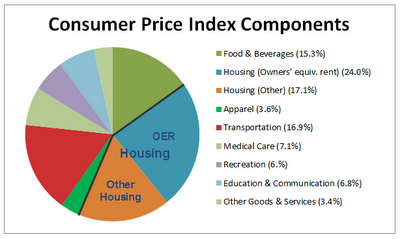Posted on April 17, 2014 by Charles Hugh Smith
So why does the government maintain such a transparently inaccurate and misleading metric? For three reasons.
That the official rate of inflation doesn’t reflect reality is obvious to anyone paying college tuition and healthcare out of pocket. The debate over the accuracy of the official consumer price index (CPI) and personal consumption expenditures (PCE–the so-called core rate of inflation) has raged for years, with no resolution in sight.
The CPI calculates inflation based on the prices of a basket of goods and services that are adjusted by hedonics, i.e. improvements that are not reflected in the price of the goods. Housing costs are largely calculated on equivalent rent, i.e. what homeowners reckon they would pay if they were renting their house.
The CPI attempts to measure the relative weight of each component:
Many argue that these weightings skew the CPI lower, as do hedonic adjustments. The motivation for this skew is transparent: since the government increases Social Security benefits and Federal employees’ pay annually to keep up with inflation (the cost of living allowance or COLA), a low rate of inflation keeps these increases modest.
Over time, an artificially low CPI/COLA lowers government expenditures (and deficits, provided tax revenues rise at rates above official inflation).
Those claiming the weighting is accurate face a blizzard of legitimate questions. For example, if healthcare is 18% of the U.S. GDP, i.e. 18 cents of every dollar goes to healthcare, then how can a mere 7% wedge of the CPI devoted to healthcare be remotely accurate?
In my analysis, the debate over inflation is intrinsically flawed. What really matters is not the overall rate of inflation, which can be endlessly debated, but the purchasing power of earned income, i.e. wages and the exposure to real-world costs.
In other words, those households with zero exposure to college tuition and the full costs of daycare, medical care and healthcare insurance may well experience low inflation, while the household paying the full costs of daycare, college tuition and healthcare insurance will experience soaring inflation.
Here’s one example of how CPI fails to capture real-world inflation/loss of purchasing power. Let’s say an employee works for a company or agency that pays his/her healthcare insurance. The monthly cost has risen from $1,000/month to $1,500/month. The employee’s wage has remained stagnant but the total compensation costs paid by the employer have gone up by $500/month.
Now the employer shifts that $500/month to the employee as their share of the healthcare insurance cost. Since the average full-time worker earns around $40,000 a year, and pays around 18% in taxes, their take-home pay is around $33,000 annually.
The employee’s co-pay of $6,000 a year ($500/month) represents 18% of their take-home wage. This is an 18% reduction in earnings, or the equivalent of 18% inflation (i.e. a reduction in purchasing power).
This shifting of the skyrocketing burden of healthcare costs acts the same as 20% inflation, yet it doesn’t even register in the current CPI.
The geography of inflation doesn’t register, either. Soaring rents in Brooklyn, NY and the San Francisco Bay Area have a profound effect on those exposed to these rapidly rising costs, yet these impacts are massaged to zero by national CPI calculations.
So once again we have a bifurcated society: those protected by the state from rising costs and those exposed to real-world reductions in purchasing power. Households that receive government subsidies and direct payments have little exposure to real-world healthcare costs, since they are covered by Medicaid, and modest exposure to housing if they receive Section 8 benefits (Section 8 recipients pay 30% of their income for rent, regardless of the market price of the rental). Retirees on Medicare also have limited exposure to the real-world costs of their care paid by the government.
If we analyze inflation by these two metrics, we find the middle class is increasingly exposed to skyrocketing real-world prices. Pundits in the top 5% have the luxury of pontificating on the accuracy of the CPI while those protected by government subsidies and coverage have the luxury of wondering what all the fuss is about. Only those 100% exposed to the real costs experience the full fury of actual inflation.
So why does the government maintain such a transparently inaccurate and misleading metric? For three reasons: 1) it is useful propaganda; 2) it suppresses the state’s cost-of-living increases and 3) it lowers the government’s cost of borrowing. The benefits of reducing COLA adjustments are self-evident, as is the benefit of borrowing money at low rates of interest, but the propaganda benefits are more subtle.
The key to enabling the endless printing of money that enriches the banks and the top .1% is low inflation. Asset bubbles can be inflated, ballooning the wealth of the owners of the assets, as long as inflation is near-zero.
Indeed, the Federal Reserve claims it must print money to counter low inflation.
READ MORE…